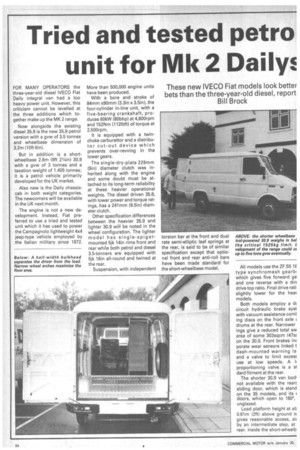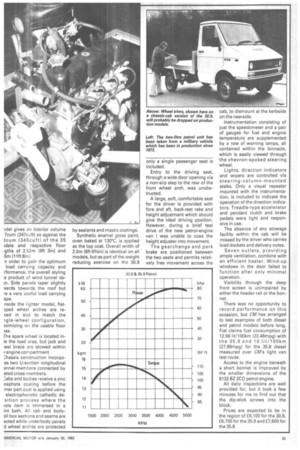Tried and tested petro unit for Mk 2 Dar,
Page 52

Page 53

If you've noticed an error in this article please click here to report it so we can fix it.
These new IVECO Fiat models look better bets than the three-year-old diesel, report Bill Brock
FOR MANY OPERATORS the three-year-old diesel IVECO Fiat Daily integral van had a too heavy power unit. However, this criticism cannot be levelled at the three additions which together make up the MK 2 range.
Now alongside the existing diesel 35.8 is the new 35.9 petrol version with a gvw of 3.5 tonnes and wheelbase dimension of 3.2m (10ft 6in),
But in addition is a shortwheelbase 2.8m (9ft 21/4in) 30.9 with a gvw of 3 tonnes and a taxation weight of 1.405 tonnes; it is a petrol vehicle primarily developed for the UK market.
Also new is the Daily chassiscab in both weight categories. The newcomers will be available in the UK next month.
The engine is not a new development. Instead, Fiat preferred to use a tried and tested unit which it has used to power the Campagnolo lightweight 4x4 jeep-type vehicle employed by the Italian military since 1972. More than 500,000 engine units have been produced.
With a bore and stroke of 84mm x90mm (3.3in x 3.5in), the four-cylinder in-line unit, with a five-bearing crankshaft, produces 60kW (80bhp) at 4,600rpm and 152Nm (112Ibft) of torque at 2,50Orpm.
It is equipped with a twinchoke carburettor and a distributor cut-out device which prevents over-revving in the lower gears.
The single-dry-plate 229mm (9in) diameter clutch was inherited along with the engine and some doubt must be attached to its long-term reliability at these heavier operational weights. The diesel driven 35.8, with lower power and torque ratings, has a 241mm (9.5in) diameter clutch.
Other specification differences between the heavier 35.9 and :ighter 30.9 will be noted in the wheel configuration. The lighter model has single-spigotmounted 5jk 14in rims front and rear while both petrol and diesel 3.5-tonners are equipped with 5jk 16in all-round and twined at the rear.
Suspension, with independent torsion bar at the front and dual rate semi-elliptic leaf springs at the rear, is said to be of similar specification except that optional front and rear anti-roll bars have been made standard for the short-wheelbase model.
All models use the ZF S5 1E type synchromesh gearb, which gives five forward ge and one reverse with a dirt drive top ratio. Final drive rati, slightly lower for the heaN models.
Both models employ a di circuit hydraulic brake syst with vacuum assistance comt ing discs on the front axle drums at the rear. Narrower ings give a reduced total sw area of some 303sqcm (47sc on the 30.9. Front brakes in porate wear sensors linked t dash-mounted warning la and a valve to limit excess use at low speeds. A Li proportioning valve is a Si dard fitment at the rear.
The shorter 30.9 van bod, not available with the rearE sliding door, which is stand on the 35 models, and its r doors, which open to 180°, unglazed.
Load platform height at ab 0.61m (2ft) above ground 1€ gives reasonable access, au( by an intermediate step, at rear. Inside the short-wheelb
)del gives an interior volume 7cum (247cuft) as against the 3curn (3 4 6cuft) of the 35 )dels and respective floor igths of 2.52m (8ft 3in) and ,5m (11ft 8in).
n order to gain the optimum load carrying capacity and rformance, the overall styling a product of wind tunnel dein. Side panels taper slightly 'yards towards the roof but ee a very useful load carrying ape.
nside the lIghter model, flat)ped wheel arches are reced in size to match the -llgle-wheel configuration, )ximizing on the usable floor )as.
ihe spare wheel is located inle the load area, but jack and ieel brace are stowed within ) engine compartment.
2hassis construction incorpoes two U-section longitudinal annel-members connected by eted cross-members.
::abs and bodies receive a zinc osphate coating before the mer part coat is applied using electrophonetic cathedic
desition process where the iole item is immersed in a int bath. All cab and bodyall box sections and seams are ected while underbody panels
d wheel arches are protected by sealants and mastic coatings.
Synthetic enamel gloss paint, oven baked at 130°C, is applied as the top coat. Overall width of 2.0m (6ft 63/4in) is identical on all models, but as part of the weight reducing exercise on the 30.9
only a single passenger seat is included.
Entry to the driving seat, through a wide door opening via a non-slip step to the rear of the front wheel arch, was unobstructed.
A large, soft, comfortable seat for the driver is provided with fore and aft, back-rest rake and height adjustment which should give the ideal driving position. However, during a brief test drive of the new petrol-engine van I was unable to coax the height adjuster into movement.
The gearchange and park brake are positioned between the two seats and permits relatively free movement across the cab, to dismount at the kerbside on the nearside.
Instrumentation consisting of just the speedometer and a pair of gauges for fuel and engine temperature are supplemented by a row of warning lamps, all contained within the binnacle, which is easily viewed through the chevron-spoked steering wheel.
Lights, direction indicators and wipers are controlled via steering-column-mounted stalks. Only a visual repeater mounted with the instrumentation, is included to indicate the operation of the direction indicators. Treadle-type accelerator and pendant clutch and brake pedals were light and responsive in use.
The absence of any stowage facility within the cab will be missed by the driver who carries load dockets and delivery notes.
Seven outlets, providing ample ventilation, combine with an efficient heater. Wind-up windows in the door failed to function after only minimal operation.
Visibility through the deep front screen is unimpaired by either the header rail or the bonnet.
There was no opportunity to record performance on this occasion, but CM has arranged to test examples of both diesel and petrol models before long. Fiat claims fuel consumption of 12.56 lit/100km (22.48mpg) with the 35.9 and 10 lit/1 0 Okm (27.99mpg) for the 35.8 diesel measured over CM's light van test route.
Access to the engine beneath a short bonnet is improved by the smaller dimensions of the 6132 BZ 2C0 petrol engine.
All daily inspections are well provided for, but it took a few minutes for me to find out that the dip-stick screws into the block.
• Prices are expected to be in the region of £6,100 for the 30.9, £6,700 for the 35.9 and £7,600 for the 35.8
























































